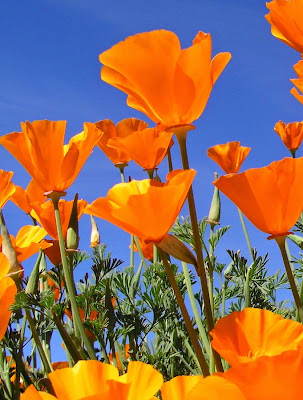Recently I've had the opportunity to work on a couple projects with Daniel Smith Artists' Materials. Their paints have been a mainstay in my palette for years.
For this demonstration of the "Hollyhock" I worked with a set called the "Essentials". The new set has six 5ml transparent watercolors. The pigments were carefully selected to give you a wide range of colors and values. When mixed together the colors you can create are endless!
Hansa Yellow Light, New Gamboge, Quinacridone Rose, Pyrrol Scarlet, Phthalo Blue GS and French Ultramarine
Hollyhocks, By Brenda Swenson
Step 1: Drawing
I start by drawing with a 2B pencil on Arches 140lb cold press paper. I am especially aware of the space and shapes between the flowers, stem and leaves (negative space). I want shape and size variety. I draw enough to get the general shapes, but don't over draw. I want to leave opportunities for shapes to develop in the painting process.
Step 2: Selecting Colors
 I use transparent paint to build up glazes. To determine which 3 colors I will use for the underpainting I make numerous color swatches. The paint needs to be the same consistency to encourage good mixing on the paper. I'm looking for interesting combinations (how they mix when wet, range of colors, range of values and do they relate to my subject). The 3 paint colors I selected are Daniel Smith: Hansa Yellow Light (HYM), Quinacridone Rose (QR), and Phthalo Blue GS.
I use transparent paint to build up glazes. To determine which 3 colors I will use for the underpainting I make numerous color swatches. The paint needs to be the same consistency to encourage good mixing on the paper. I'm looking for interesting combinations (how they mix when wet, range of colors, range of values and do they relate to my subject). The 3 paint colors I selected are Daniel Smith: Hansa Yellow Light (HYM), Quinacridone Rose (QR), and Phthalo Blue GS.
Step 3: Underpainting
I wet the entire paper with clean water and introduce the 3 paint colors separately onto the wet surface. I paint at an angle to encourage mixing as the paint moves. I don’t over work the surface with a paint brush but encourage the paint to mix on the paper. Let completely dry.
Step 4: Start Glazing
I continue with my Mother Colors (original 3 colors) but I also pull out French Ultramarine and New Gamboge. When I bring a new color to the mix it always touches one of the Mother Colors. I start at the top working my way down the paper with a mixture of French Ultramarine and New Gamboge. Painting hard edges against the flowers to carve out the big shapes. As I move down the page I push the colors towards green with Phthalo Blue GS. Let completely dry.

Step 5: Shadows
I begin to define the flowers with a mixture of Quinacridone Rose and Pyrrol Scarlet. The surface is completely dry. As the form turns towards the light I have a variety of edges. Form shadows have soft edges and cast shadows have hard edges. I soften the form shadow edges with clean water. Let completely dry.
Step 6: Negative Painting and Final Details
In the final stage I paint the darkest darks, smallest shapes and add final details. I focus on carving around the shapes (negative painting) to suggest the stem and leaves. On my palette I make two puddles of Phthalo Blue GS and Hansa Yellow Light. I allow these two puddles to mingle slightly. I don't let the colors over mix. Each brush load will have a slight shift in color. I also drop a little Quinacridone Rose into the darkest area of green below the largest flower. The unexpected warmth livens up the area.
I finish by adding final details. I start with the center of the largest flower using Phthalo Blue GS and while still wet I add a touch of New Gamboge. Next I paint the darkest shadows on the flower petals. I make a reddish purple mixture with French Ultramarine and Quinacridone Rose. The greatest saturation of color will be in the darkest shadows.
Hope you’ve enjoyed this short demonstration. If you were unfamiliar with these paint colors hopefully I’ve opened your eyes to their wonderful transparency, richness and mixing ability!
You can see them here: The Essentials
Happy Painting!
Brenda
NWWS, SDWS, WW
www.SwensonsArt.net
© Copyright 2019, Brenda Swenson retains copyrights to all artwork. All images on this site are property of Brenda Swenson and may not be used in any way for commercial, financial or personal without prior written consent. All Rights Reserved for republication (printed, digital or painted) and anything but personal viewing of artworks on this site.









